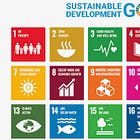How to get the UN's development goals off life support?
An update on the drive to revive the SDGs 🌐
WorldWise readers—
Swimming against the current is hard work. But right now, the UN is one space where a sizeable global community can join efforts to keep afloat a vision for a healthier future on this planet that, chances are, would otherwise sink under the weight of multiple crises.
This post—one of occasional emails during our summer break—rounds up recent coverage of high-level discussions and media commentary on how to drive progress towards meeting the sustainable development goals. Plus highlights of other stories, a glimpse of the reality this agenda is up against.
Anita
VIEW EDITION | a global take on pressing issues for humanity
INSIGHT | views & analysis
Keeping calm and carrying on.
Between 8-17 July, the UN convened the annual session of the High-level Political Forum on Sustainable Development (HLPF 2024) in New York City, under the theme “Reinforcing the 2030 Agenda and eradicating poverty in times of multiple crises". The meeting is part of a process to support the implementation of the Political Declaration agreed at last year’s SDG Summit, in an attempt to advance the Sustainable Development Goals (SDGs).
According to observers the HLPF concluded with the adoption of a Ministerial Declaration, which fairly innocuously identifies current challenges and ways forward, reiterating existing commitments. Things get a little more interesting—and revealing of sociopolitical tensions that play a part in undermining progress—with the inclusion of a couple of politically loaded and therefore contested paragraphs: one stating that sustainable development cannot be realised without peace and security; and the other objecting to economic sanctions on the basis that they undermine developing countries’ development aspirations.
Thirty-eight countries presented SDG progress reports at the event, which focused on an in-depth review of five goals: SDG 1 (no poverty), SDG 2 (zero hunger), SDG 13 (climate action), SDG 16 (peace, justice and strong institutions), and SDG 17 (partnerships for the Goals). A three-day ministerial segment focused on how the multilateral system can support commitments made at last year’s Summit.
As we’ve heard many times before, as things stand the outlook is pretty grim. In the lead-up to this year’s event, the 2024 Sustainable Development Goals Report confirmed the failure to make enough progress on the goals since they were adopted in 2015, with over one-third of the targets stalled or going in reverse. Progress is “alarmingly insufficient”, the UN says in the report.
So much, so familiar. But what to do about it?
Proponents of this agenda aren’t disheartened. Although those who argue for abandoning the SDGs are in the minority, a group of experts including the influential Jeffrey Sachs recently argued in Nature against calls to abandon the goals, instead backing an extension of the agenda to 2050. They write:
Because all of these global crises are interlinked, only a holistic and global approach to solving them will work. The SDGs should remain at the centre of global policy agendas.
Read: we’re too far own the road for a radical change of course to be on the cards.
Finance and beyond
In discussions dissecting why progress has stalled, many analysts centre their diagnosis on the successive economic shocks the world has suffered since 2015, which have left many developing countries unable to invest in social spending.
A report released by the UN Conference on Trade and Development (UNCTAD) in the lead-up to this month’s meeting found that in 2023, global foreign direct investment in sectors linked to the SDGs dropped by 10%. In April, writing for Devex, Miguel Antonio Tamonan traced where the money spent on meeting the SDGs actually went. The gist: three SDGs took home the most money in 2022 and 2021—SDG 17 on partnerships to achieve the goals; SDG 3 on good health and well-being; and SDG 7 on affordable and clean energy.
Nancy Birdsall and colleagues at the Center for Global Development home in the problem of limited funds and see “cause for optimism” in steps underway to reform the way international financing has worked over the past decades:
Eighty years since the first Bretton Woods model was launched, the more than 100 country members of the International Monetary Fund (IMF) and the major MDBs—North and South—are implementing three breakthroughs in the international funding of social and economic development, and climate adaptation and mitigation, in developing countries.
The way money flows (or doesn’t) is usually the focus of calls for bolder action—but a bigger obstacle is “the lack of systematic approaches to creating scalable solutions”, argue John W. McArthur and Zia Khan in a commentary for Project Syndicate:
Achieving the SDGs by 2030 requires new approaches that are audacious enough to inspire but also practical enough to be viable—concepts that capture the imagination while steering implementation debates toward tangible results.
Targeting the overlaps
The development agenda isn’t the only global agenda struggling to gain traction. And although it’s separate from UN processes designed to address climate change and loss of biodiversity, in the real world the challenges are, of course, very much connected (more on this below).
Writing in Global Policy Journal, Martha Molfetas argues that, as part of the global development agenda, countries should tackle the overlap between the SDGs, the climate crisis and “economic transformation”:
The HLPF should ensure that resource rich nations are able to tap in and utilize their own resources, without the need to export raw materials only to later import finished products. This … should centre on increasing human and social development opportunities rather than continuing exploitative resource practices of the present.
There’s now a fresh injection of funds in that direction from the Open Society Foundations. “Countries should not have to choose between pursuing prosperity for their people and protecting the planet”, said Binaifer Nowrojee, the OSF’s new President, on announcing a new $400 million fund to boost economic growth:
Over the next eight years, we will support civil society organizations and independent economic think tanks working on policy issues in countries including Brazil, Mexico, Senegal, South Africa, Malaysia, and Indonesia as they transform their economies to meet the challenges they face.
Misguided by wealth
About a month prior to the HLPF, this year’s Environmental Performance Index offered a summary of the state of sustainability around the world by tracking progress towards the three interconnected frameworks that reflect the major challenges of our time: the SDGs, the goals of the Paris Agreement on climate change, and the targets of the Kunming-Montreal Global Biodiversity Framework. Produced by groups at Yale and Columbia universities, it points out who’s leading and who’s stalling.
This passage, taken from the Policymakers’ Summary document, is worth highlighting for its challenge to the notion that increasing wealth translates to better protection of life on this planet:
EPI scores are positively correlated with a country’s wealth, although after a point, increasing wealth yields diminishing returns. At every level of economic development, though, some countries outperform their peers while others lag. And indeed, some of the poorest countries in the world outperform some of the richest. In this regard, factors other than wealth, such as investments in human development, rule of law, and regulatory quality, are stronger predictors of environmental performance.
It really is the bottom line. And as I’ve argued before, the story can change. Whether or not the UN’s efforts will be pivotal remains to be seen.
PS—previous posts on this topic:
BRIEFING | around the world
On the reach of new tech
One of the most iconic images of rural Vietnam involves farmers with conical hats bending over rice fields to scatter seeds or plant seedlings—but this may be about to change, as drones are slowly taking over tasks like scattering seed, spraying pesticide, or spreading fertiliser, Chiara Negrello reports for Hakai magazine.
Copper is a vital part of the infrastructure that powers the data processing capacity needed to run AI → and AI has now helped find millions of tons of copper reserves in Zambia, Max Bearak reports for The New York Times. (A somewhat disturbing act of passive self-propagation?)
In early July the United Nations adopted a non-binding resolution to create a “free, open, inclusive and non-discriminatory” approach to AI development, Khushboo Razdan reports for SCMP. The resolution was led by China, which is positioning itself as an advocate for developing countries’ rights to benefit from the technology, says Joanna Chiu in an update for Rest of World. Pushing for more state control over the internet is part of the agenda, Colum Lynch reports for Devex.
Nathan Gardels, editor-in-chief of Noema Magazine, sees something sinister in how the ruling parties of China and India—the world’s two largest nations—are embracing high-tech tools. He writes:
“Conjoining the newest technologies of connectivity with old-style politics — ward bosses to keep constituencies in line and patronage in exchange for loyalty — is the dream of autocrats everywhere who seek to perpetuate their rule or the rule of their parties, elections or not.”
On environmental protection
In June, the Food and Agriculture Organization said that more fish were farmed than scooped out of the ocean in 2022 for the first time ever, according to news reports.
The EU’s new deforestation regulation is upending trading practices by demanding that firms importing products like cocoa, coffee palm oil or wood can trace their origin. Designed to curb deforestation by ensuring the commodities do not come from land deforested after 2020, there’s concern that the costs involved will put smallholders at risk, according to the Economist.
Cote d’Ivoire has become the 10th African country to join the UN Water Convention, UNECE announced in mid-July. The treaty aims to improve joint water management across borders. A total of 53 countries have signed up since the Convention came into effect in the early 1990s.
A new generation of Indigenous forest defenders are making their voices heard via international conferences, climate summits, and social media networks, fighting to protect the Amazon from damaging development activities, Isabel Alarcón writes in Atmos.
On the energy transition
Whoever controls the energy supply controls the new world order, energy expert Art Berman tells Rachel Donald in Planet: Critical:
Russia and China are deepening their relationship, Western allies in the Middle East are joining the fossil-fuelled BRICS alliance spanning the globe, and the Wagner group is loosening Europe’s grip of Africa. The tectonic plates of geopolitics are shifting along new fault lines as rising powers focus on securing resources while the old Empire in the West pretends it can decouple economies and energy. The world is at war, but only one side is being honest about what for.
Italy is looking to import green energy produced in North Africa by supporting a project that would set up solar panels in Tunisia and Algeria and transfer the energy to Tuscany and Liguria via subsea lines, Alberto Brambilla and Donato Paolo Mancini report for Bloomberg.
Introducing a Guardian series on The Latin Oil Rush, LAC editor Andrei Netto points out the region’s moves in a direction that goes against the global shift towards renewable energies and reducing greenhouse gas emissions.
The quest for oil has mobilised 16 of the 33 countries in the region, according to the International Energy Agency, and often neglecting energy transition and environmental preservation along the way. “We’re not going to waste any opportunity to grow,” argued the Brazilian president, Luiz Inácio Lula da Silva, in June.
Even Ecuador, which voted against oil extraction in a referendum last year, is now back to following the LAC pack, reluctant to abandon an industry which has supported its economy for decades, reports Kimberley Brown for the Guardian.
On the costs of the climate crisis
In an opinion for CNN, journalist Jeff Goodell points out that the world was built for a climate that no longer exists—what he calls a “central truth” that’s becoming harder to ignore.
The rate at which climate change is expected to shrink wealth is on par with financial losses of a continuing permanent war, according to research that also estimates that a 1C increase in global temperature leads to a 12% decline in GDP—six times higher than previously thought, reports Oliver Milman for the Guardian.
Research from Mexico shows connections between extreme heat and higher rates of financial distress among small and medium enterprises, an indicator of economic repercussions that come with climate change, Sandra Aguilar-Gomez writes in VoxDev.
Some homeowners are forced to borrow money to buy air conditioners as increasingly extreme heatwaves take hold in India, Cheena Kapoor reports for Global Health NOW.
Over 210 million children had to lose days or weeks of school earlier this year as scorching temperatures forced school closures in April and May, likely an underestimate as official data is scarce, Diego Arguedas Ortiz reports for Devex.
Proposals for how to respond to the devastating flooding and landslides that hit southern Brazil in May are rushed and misguided, favouring large engineering projects that harm livelihoods and biodiversity, argue Luiz Roberto Malabarba and colleagues in a Nature letter.
On June 3rd, Panama began to move indigenous families from Gardi Sugdub island to new government-built housing on the mainland—a test case for “planned retreat” in Latin America as changing climate and rising seas are slowly sinking dozens of inhabited islands nearby, the Economist reports. Some 1,200 people are expected to make the move, according to AFP.
By 2050, half the capital of Tuvalu, an island in the Pacific Ocean, is expected to sink underwater. The capital Funafuti, where more than half of the country’s citizens live, will become flooded by tidal waters. This is forcing an existential question, Simone Stolzoff writes for the National Geographic: What happens to a country if it no longer has land?
The word for land in Tuvaluan, fenua, refers to both physical land and a sense of belonging rooted in one’s identity. In Tuvalu, land is owned communally, and passed down through family lines. Tuvaluans bury their ancestors in mausoleums beside their front doors. The land holds their relatives, history, and tradition, which makes the question of whether to leave intractable.
On global economies
Brazil plans to use its presidency of the G20 to promote “better, bigger and more effective MDBs [multilateral development banks]”, reports Vince Chadwick for Devex.
Based on an article collection titled Why Europe needs Africa, published by the Carnegie Endowment for International Peace, editor David McNair argues that “the future looks promising” for African leaders looking to take advantage of changing geopolitics to demand that they’re treated as equals.
The new UK government is about to shift some of its aid budget—and work with the European Union—to reduce the influx of asylum-seekers from Africa by boosting economic opportunities in home countries, Rob Merrick reports for Devex.
A large chunk of poorer countries economies are informal, and pinning them down in statistics can be difficult. But a step forward for Nigeria on that front: Moniepoint, a Lagos-based fintech company, has produced a report showing that 90% of Nigeria’s 40 million small and medium-sized businesses are part of the informal economy, says David Adeleke in an update for Rest of World.
On global health
Conflicts and other humanitarian crises are the key reasons behind a rise in unvaccinated children globally, report Kat Lay for the Guardian and Jenny Lei Ravelo for Devex.
Officials are concerned about the potential for global spread of a new strain of the viral disease formerly known as monkeypox, which shows signs of unusual behaviour after a mutation first reported several weeks ago. The Telegraph’s Maeve Cullinan reported that the new mpox strain can spread without sexual contact.
A new study found that tackling malaria, TB, and HIV pays for itself 405 times over, making it possibly the world’s best investment, Dylan Matthews reports for Vox.







